

Extreme Metagames and How to Approach Them
A successful Gwent deck cannot simply be powerful in a vacuum. It must also be powerful relative to the metagame, the field of decks it could face. Metagaming, the skill of anticipating and adapting to changes in the field, is critical for top-tier Gwent success; over time, a player who adds metagaming to their skill set will encounter more favorable matchups and achieve better results.
Like most new collectible card games, Gwent has experienced an ever-shifting and often extreme metagame. Metagame health is a spectrum; there is no set point where a healthy metagame becomes extreme. Top players recognize roughly when a metagame is extreme, however, and react accordingly. After touching on healthy metagames, this article explores the several types of extreme metagames and how players can use them to their advantage.
Two Notes
1. This article focuses on Ranked Play. Pro Ladder metagaming differs greatly for several reasons, among them the need to play various factions to unlock their MMR and the different matchmaking system.
2. Metagame data gives only aggregate performance; while one leader may be the most-played with the highest win percentage in a given week, a specific build of another deck could have performed better.
Healthy Metagames
If all Gwent cards and decks were truly interchangeable, choosing a deck would become meaningless and the game would be terrible to play besides. Instead, a healthy metagame offers a wide but not infinite number of choices for players, allowing great variety in play styles and factions.
One of the most fondly remembered Gwent metagames was in December 2017, right before Gwent Challenger #2 and the Midwinter Update. The GwentUp Meta Report for 9 – 15 December 2017 shows a reasonably healthy metagame in the top tiers of Ranked Play:

All Meta Reports and screenshots thereof courtesy of the GwentUp Archives.
All but three leaders fall within a 45-55% win rate band, with King Radovid V just below the lower bound and Harald the Cripple and Dagon accounting for just 0.5% of the metagame between them. Further, while the best-performing leader, Emhyr var Emreis at the head of Nilfgaard Spies, is also the most-played in the metagame, its five most frequent matchups fall into the same 45%-55% band...with the exception of Eredin Bréacc Glas at a 39% win rate, a "safety valve" in case Emhyr got out of hand.

A healthy metagame offers tangible yet limited rewards for metagaming. If a player can expect to face a certain deck roughly one in five times, as with the Nilfgaard Spies deck above, filling flex spots with cards that are strong against it can make sense.
Switching archetypes to take advantage of the field is less viable. Using 9 – 15 December 2017 as an example, by the same margin Eredin decks beat Nilfgaard Spies, they lost to King Henselt and King Foltest decks, the second- and third-most-popular in the top tiers of Ranked Play.
Extreme Metagames: The Narrow Metagame
If a healthy metagame offers a wide choice in decks, a narrow metagame, as the name implies, offers a small number of viable decks and concentrates more of the field into the same few archetypes.
In the 9 – 15 December 2017 Meta Report, the top three most played leaders totaled 51.5% of the field in GwentUp's highest grouping for Ranked Play. The corresponding figure in the 21 – 27 April 2018 Meta Report was 56%. While no leader exceeded a 55% win rate in the latter report, leaders with a sub-45% win rate made up 10.8% of the field, showing how the narrowing metagame strongly punished outliers.
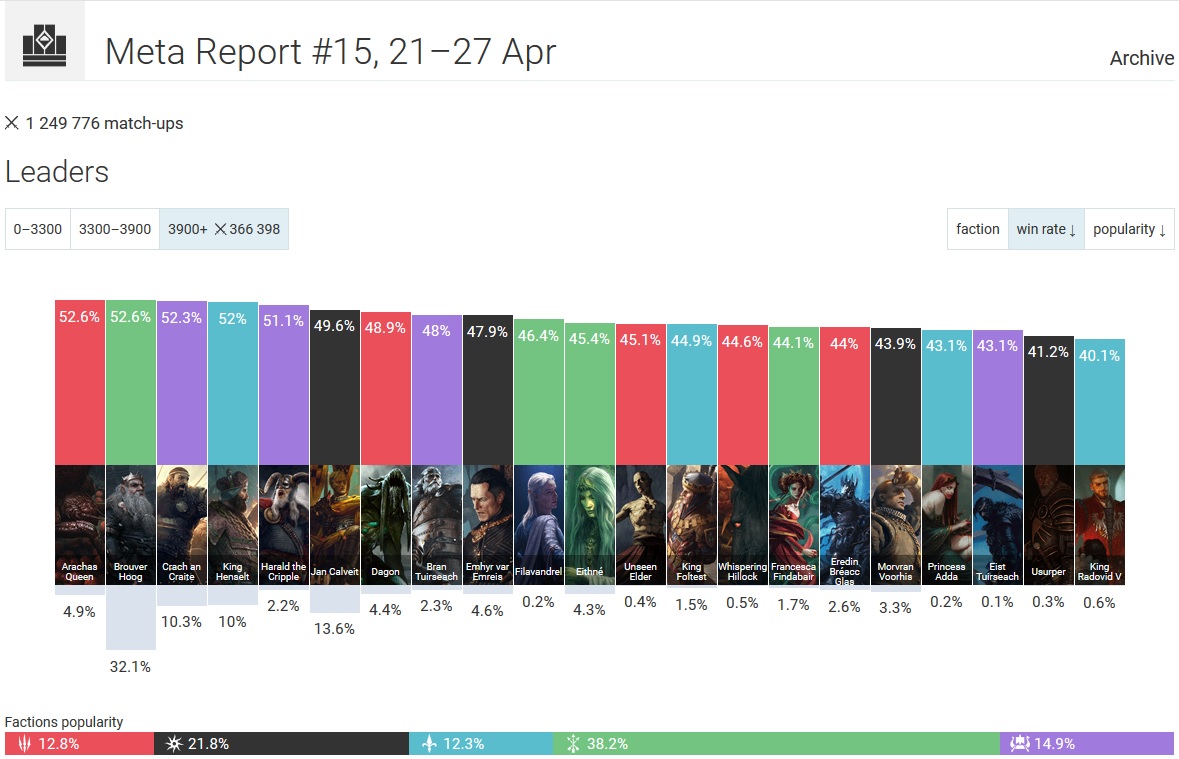
Narrow metagames almost inevitably feature one or more decks the community will refer to as "a problem." In the 21 – 27 April 2018 Meta Report, the most popular leader, Brouver Hoog, made up more than 32% of the field, compared to less than 20% for Emhyr var Emreis in 9 – 15 December 2017.
Further, Brouver Hoog did so while tying with Arachas Queen for the best win rate in the format. It crushed most outliers, held a clear edge on second most popular leader Jan Calveit, and stayed effectively neutral with the third and fourth most popular leaders, Crach an Craite and King Henselt.
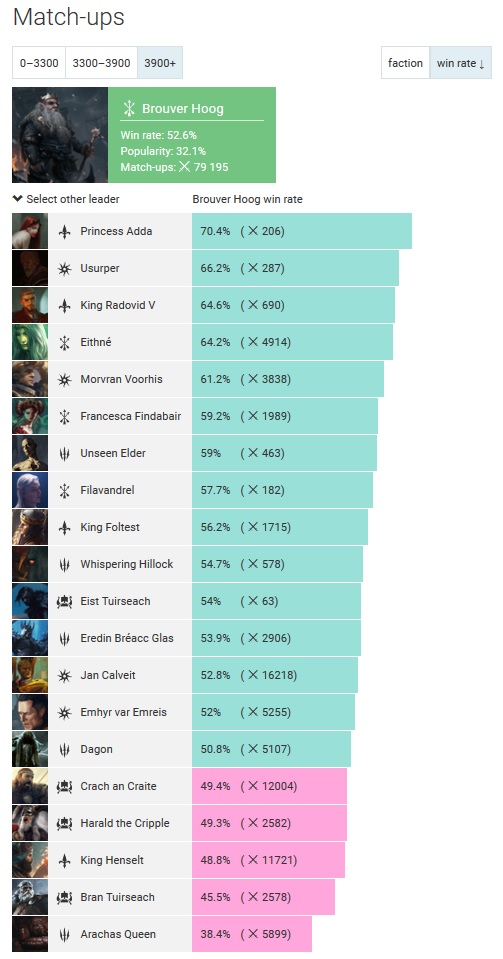
A narrow metagame offers significant rewards for metagaming. The performance of Arachas Queen decks in the 21 – 27 April 2018 metagame illustrates this well. Arachas Queen decks matched up poorly against Crach an Craite (42.9% win rate) and even worse against King Henselt (35.9%), yet Jan Calveit (56.7%) and Brouver Hoog (60.4%) made up so much of the field that it wound up an excellent pick.
By contrast, Jan Calveit proved poorly positioned in the same week. It won only 45% of its matches against Brouver Hoog, putting it in a deep hole, and was either neutral or a slight underdog against Crach an Craite and King Henselt. Add in sub-45% performances against Arachas Queen and Dagon, and Jan Calveit could not make up enough ground against the rest of the metagame for a winning record.
In a narrow metagame, look for a strong deck without a target on it. When most of the top-tier Ranked Play metagame was focused on Brouver Hoog and its spread-out points, Arachas Queen's Consume-based engine and cards that climbed swiftly out of Viper Witcher range could thrive. King Foltest, on the other hand, was beaten at its own "spread out the points" gameplan by Brouver Hoog while suffering from the same weaknesses, and thus saw little play and even less success.
Extreme Metagames: The Deck/Anti-Deck Metagame
While a narrow metagame still allows for at least three distinct top-tier decks that can increase and decrease in popularity as time goes by, things can get even more extreme. A "deck/anti-deck" metagame flattens the metagame into three parts: one strong deck, a second "anti-deck" that defeats the strong deck's strategy, and "the rest."
CD Projekt Red rightly saw Brouver Hoog's ubiquity as a problem and reduced the card's power in May 2018's "Swap Update" by making it unable to find a card advantage spy. The Swap Update also saw most bronze cards with the Create mechanic reworked, altering and weakening the play patterns of three of the top four pre-update leaders. While I believed Greatswords also would be weakened in May's Swap Update, this did not happen. As a result, the metagame cure proved worse than the disease.
The first glimpse of the post-Swap Update metagame, covering 26 May – 1 June 2018, seems healthy on the surface. Sub-45% leaders are at 5.7% of the metagame. The three most frequently played leaders total only 50% of the field in GwentUp's highest Ranked Play grouping. The most played leader, Crach an Craite, is at 22% of the field, closer to pre-Midwinter Emhyr var Emreis than pre-Swap Brouver Hoog. Crach's win rate of 53.7% is higher than the recurring 52.6% figure, but not alarming.
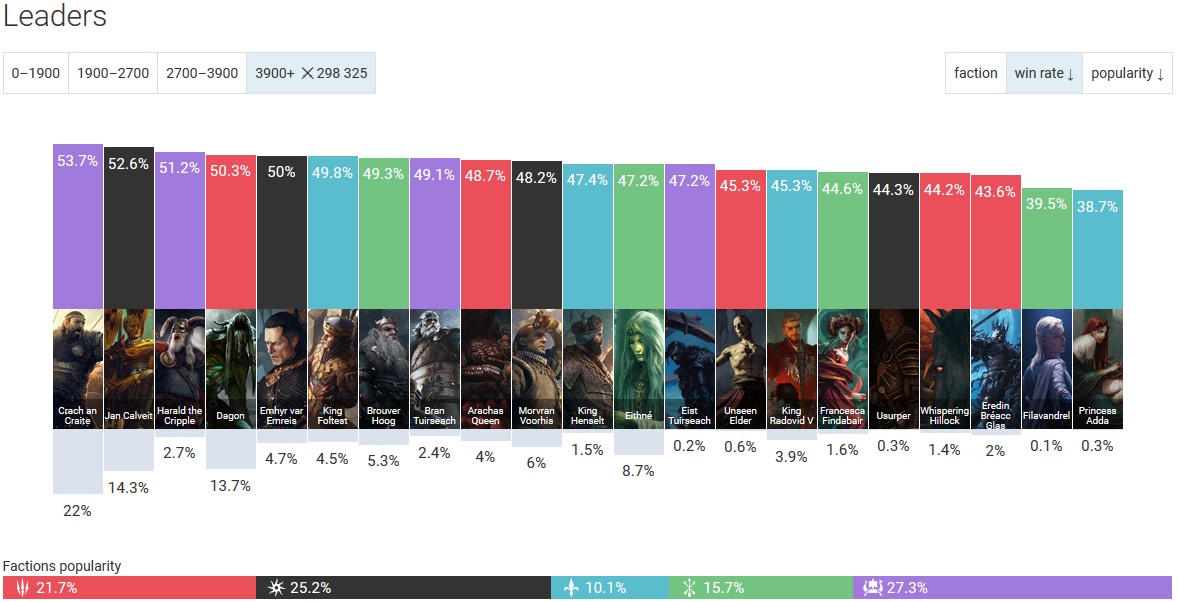
Yet this immediately post-update metagame already resembles metagames from several weeks after a change. Checking Crach an Craite's statistics reveals the ugly truth: Crach had a winning record against every other leader except Jan Calveit, and even there its win rate was 45.5%.
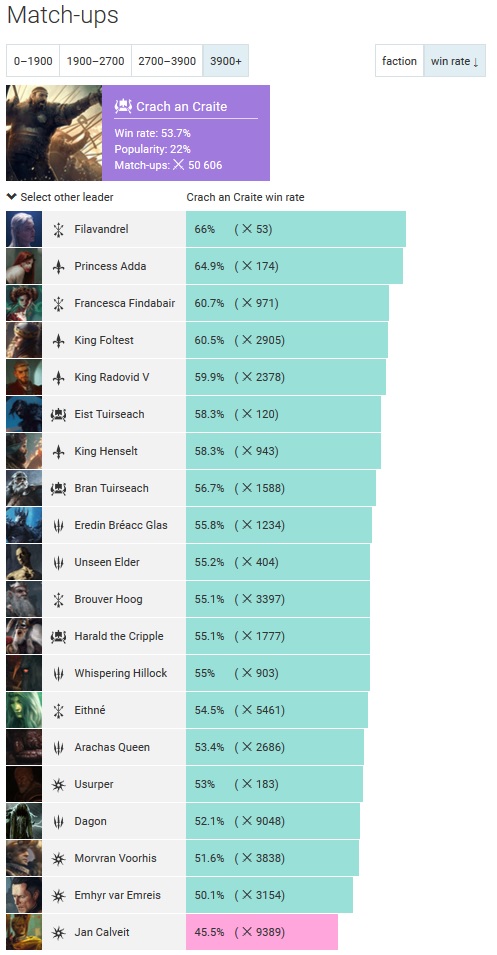
With Crach an Craite (an Craite Greatswords) as the strong deck, Jan Calveit (specifically, Jan Calveit Alchemy) emerges as the anti-deck. While its anti-deck properties help secure it a winning record, several potential hazards lurk among "the rest" that could swiftly topple it from a dominant position, most notably Harald the Cripple-based Axemen decks.
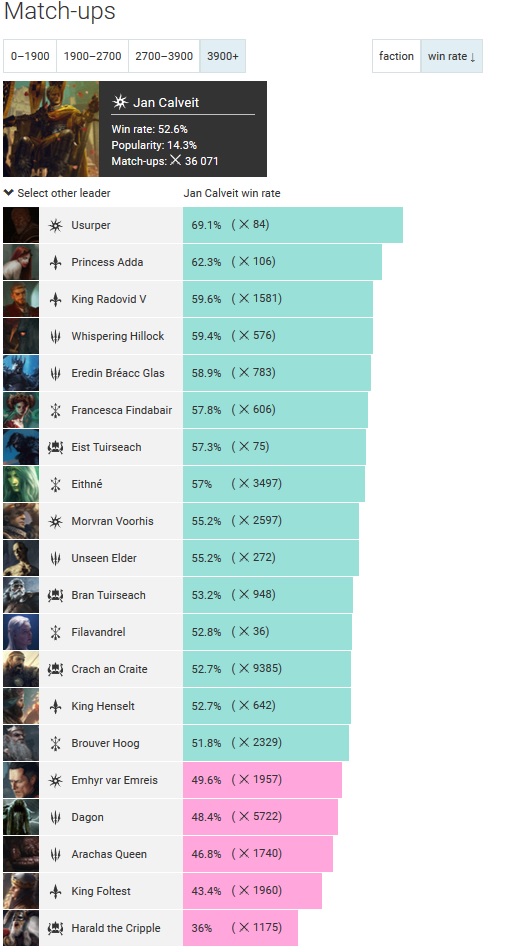
A deck/anti-deck metagame offers the highest rewards for metagaming. On one level, players can look at the three categories of "strong deck," "anti-deck," and "the rest" as rock, paper, and scissors. When the strong deck makes up much of the field, the anti-deck can prey upon it; when the anti-deck crowds out the strong deck, "the rest" thrive; and when the field is scattered, the strong deck rises again. This cycle has played out across many collectible card games for over 20 years, as I wrote about back in 2006.
On a more difficult but potentially more rewarding level, players can try to find a "meta breaker" deck that defeats both the strong deck and its anti-deck. A recent example is the rise of a non-Alchemy Jan Calveit deck built around Slave Infantry synergies with high point output and tools to break up Greatsword synergies while depriving Alchemy's Viper Witchers of good targets. The use of generically good leader Jan Calveit also creates uncertainty in opponents: are they facing Alchemy or Infantry?
Most would-be meta breaker decks never get off the ground, but the fewer decks a meta breaker must target, the better the odds. The emergence of a meta breaker can pull a deck/anti-deck metagame back to a narrow metagame, at least temporarily, to the benefit of all competitive Gwent players.
Extreme Metagames: The One-Deck Metagame
At its most extreme, a metagame can consist of precisely two parts: an extremely strong deck and a field full of losers. Any deck that can get to a 50% win rate against the extremely strong deck must warp itself around that goal so strongly that it becomes fatally compromised against the rest of the field. If, in the post-Swap Update metagame, Alchemy could not beat Greatswords, Greatswords would form a one-deck metagame.
One-deck metagames alienate all players who do not like that particular deck, and even those remaining get sick of mirror matches in a hurry. A potential one-deck metagame is a legitimate threat to a game and to the company that makes it, demanding immediate action. Swim's infamous "Stammeltael" deck, revealed after the "Gold Immunity Update" of 29 August 2017, was hotfixed into oblivion in one week.

Though metagaming rewards generally rise as metagames get more extreme, a one-deck metagame offers minimal rewards. Usually the only choice, once a player has committed to playing in a genuine one-deck metagame, is to play the extremely strong deck or refuse and get punished. After this basic decision, in-game skill becomes far more important than metagaming skill.
A player committed to a one-deck metagame has two options: join the strong deck's mini-metagame or try to find an anti-deck. If a one-deck metagame is allowed to fester, it will develop its own "mini-metagame" of card choices to win mirror matches. Alternatively, players may try to disprove the one-deck metagame by creating an anti-deck that can also withstand the rest of the field.
Of course, with the exception of a handful of people who owe their livelihoods to a game, most players are not committed to high-level play made unpleasant by an extreme metagame. For them, the famous line from the film WarGames holds true: "The only winning move is not to play."
Metagame Expectations
The examples above show how the different classifications of extreme metagames can flow into one another. The 21 – 27 April 2018 narrow metagame dominated by Brouver Hoog certainly shares some characteristics with the 26 May – 1 June 2018 deck/anti-deck metagame revolving around Greatswords, differing largely in the number of leaders and archetypes that were viable against Brouver Hoog.
Ideally, Gwent's metagame would be healthy most of the time. Realistically, a narrow (but enjoyable) metagame is where Gwent likely will end up right a few weeks after a patch. As for the deck/anti-deck metagame represented by Crach an Craite and Jan Calveit, despite an official statement not to expect updates between May and November's Homecoming, I suspect one will come anyway to lower the power of Greatswords. Homecoming may be incredible, but Gwent needs to stay viable until then.

Author
lordgort
"Professional hobbyist" lordgort makes his money helping others enjoy their leisure, whether as an auction catalog writer, copy editor for a Magic: The Gathering strategy site, or game show contestant (lifetime winnings: $5000). A Magic columnist for seven years, in 2018 he turned to Gwent, swiftly reaching the Pro ranks. Off the clock, he relaxes by writing and editing Gwent articles and contributing to Aretuza Academy. A longtime game show fanatic, he appeared on Who Wants To Be A Millionaire in 2018.




